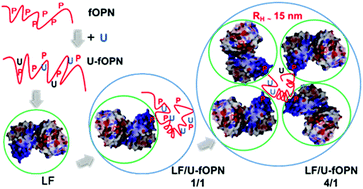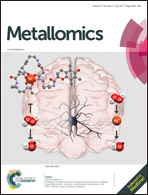Reactivity of U-associated osteopontin with lactoferrin: a one-to-many complex†
Abstract
Uranium is the heaviest natural element, mainly found in aqueous medium as the hexavalent uranyl ion (UO22+). Bones are the main organs in which uranium accumulates, depending on as yet unknown molecular and cellular mechanisms. Recently, it has been revealed that osteopontin (OPN), a protein involved in bio-mineralization processes, and its main naturally occurring cleaved form (fOPN), have nanomolar affinities for UO22+. The binding of UO22+ is due to both the phosphorylation sites and acidic residues of these proteins and is accompanied by a slight gain in secondary structure. OPN is an Intrinsically Disordered Protein (IDP), a family of proteins which play a crucial role in several interaction networks, where phosphorylations are thought to be key elements. OPN has been shown to bind lactoferrin (LF) and the two proteins have antagonist functions in the modulation of the bio-mineralization process. However, to date, there has been no evidence that UO22+ and LF compete in their binding to OPN or not. Based on a series of convergent experimental data, this study first addressed in detail the LF/fOPN interaction and proposed a LF:fOPN 4/1 maximal stoichiometry. Moreover the phosphorylations were demonstrated to be necessary for the stability of such complexes. The interaction of preformed UO22+/fOPN complexes with LF was also investigated and the occurrence of several entities involving the three partners was demonstrated. These complexes did not reveal any significant conformational changes compared to those obtained in the absence of UO22+. The results have shown not only that LF and UO22+ do not compete, but also that these complexes are likely to be more stable than LF/fOPN complexes, as indicated by their melting temperature (Tm) values. The potential impact of those uranyl-stabilized ternary complexes on some biological pathways now remains to be assessed. Nonetheless, this work has contributed to shedding light on the formation of stable ternary complexes involving a large structured protein, an IDP and an exogenous metal.

- This article is part of the themed collection: Metallomics Recent HOT articles


 Please wait while we load your content...
Please wait while we load your content...